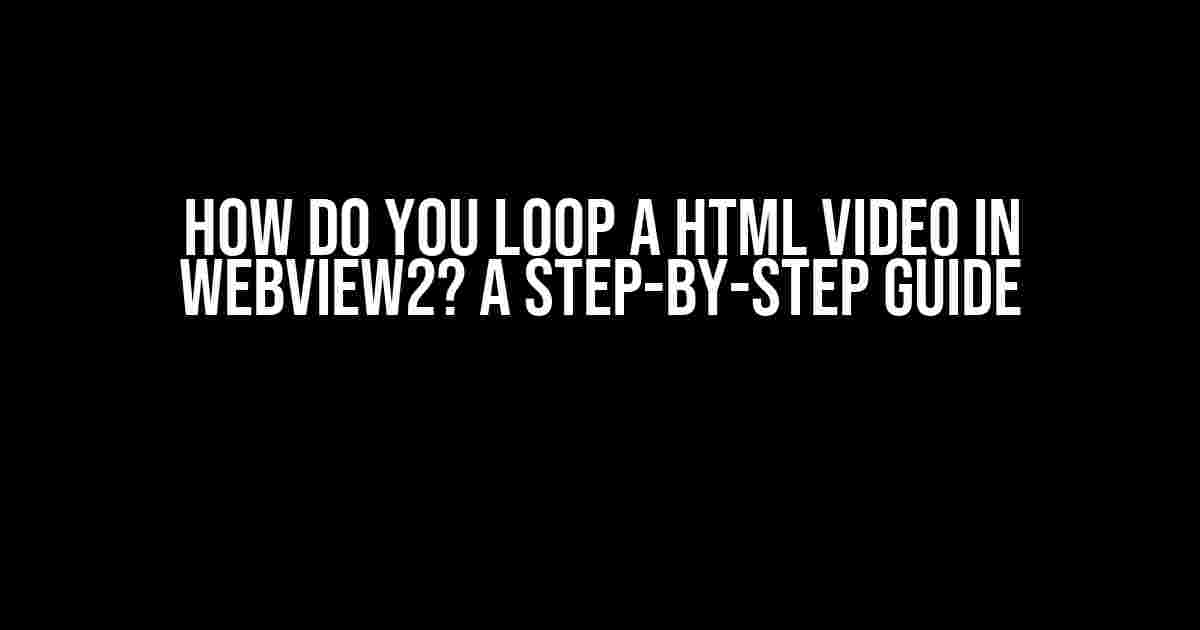Are you tired of your HTML videos ending abruptly, leaving your users wanting more? Do you want to keep them engaged by looping your videos seamlessly? Look no further! In this article, we’ll dive into the wonderful world of Webview2 and explore the secrets of looping HTML videos like a pro.
What is Webview2?
Before we dive into the nitty-gritty of video looping, let’s take a brief detour to understand what Webview2 is. Webview2 is a Chromium-based browser control for Windows 10 and later, which enables you to host web content within your desktop applications. It provides a powerful way to integrate web experiences into your apps, and is a significant upgrade to the classic Webview control.
Why Loop HTML Videos?
Looping HTML videos can be a game-changer for various scenarios:
- Background videos**: Looping a background video can create a seamless and immersive experience for your users.
- Advertising**: Looping videos can be used to showcase products or services in a continuous loop, grabbing the user’s attention.
- Training and tutorials**: Looping tutorial videos can help users understand complex concepts by repeating key steps.
- Gaming**: Looping videos can be used to create an engaging gaming experience, such as looping cutscenes or intro sequences.
How to Loop a HTML Video in Webview2
Now that we’ve established the importance of looping HTML videos, let’s get our hands dirty and explore the various methods to achieve this in Webview2.
The simplest way to loop a HTML video is by adding the `loop` attribute to the `
<video id="myVideo" loop>
<source src="video.mp4" type="video/mp4">
</video>This method is supported by most modern browsers, including Webview2. However, there’s a caveat: the video will only loop if the user interacts with it (e.g., clicks the play button). If you want the video to loop automatically, you’ll need to use JavaScript.
To loop a HTML video automatically using JavaScript, you can listen for the `onended` event and call the `play()` method:
<video id="myVideo">
<source src="video.mp4" type="video/mp4">
</video>
<script>
const video = document.getElementById("myVideo");
video.addEventListener("ended", function() {
video.play();
});
</script>This method works beautifully in Webview2, and the video will loop seamlessly.
Another approach is to use the `playlist` attribute, which allows you to specify multiple video sources:
<video id="myVideo" playlist>
<source src="video1.mp4" type="video/mp4">
<source src="video2.mp4" type="video/mp4">
<source src="video3.mp4" type="video/mp4">
</video>In this example, the video will loop through the three specified sources. You can adjust the number of sources to create a seamless loop.
Troubleshooting Common Issues
While looping HTML videos in Webview2 is relatively straightforward, you might encounter some common issues:
| Issue | Solution |
|---|---|
| Video doesn’t loop automatically | Make sure the user has interacted with the video (e.g., clicked the play button) or use JavaScript to call the `play()` method. |
| Video loops incorrectly | Check that the video sources are correctly specified and that the video is not being blocked by browser policies (e.g., autoplay blocking). |
| Video doesn’t loop at all | Verify that the `loop` attribute is correctly set and that JavaScript is enabled in the Webview2 control. |
Conclusion
Looping HTML videos in Webview2 is a breeze, and with these methods, you can create engaging experiences for your users. Whether you’re building a desktop application or a web-based solution, Webview2 provides a powerful way to integrate web content and create seamless video loops. So, go ahead and get creative with your video looping needs!
Remember to test your implementation thoroughly to ensure that it works as expected across different browsers and devices. Happy coding!
Frequently Asked Question
Get ready to master the art of looping HTML videos in Webview2! Below, we’ve got the top 5 questions and answers to help you get started.
Q1: How do I enable video looping in Webview2?
To enable video looping, you can add the `loop` attribute to your HTML video element. For example: ``. This will allow the video to automatically start playing again from the beginning once it reaches the end.
Q2: Can I use JavaScript to loop a video in Webview2?
Yes, you can use JavaScript to loop a video in Webview2. You can use the `video` element’s `addEventListener` method to listen for the `ended` event, and then use the `play()` method to restart the video from the beginning. For example: `const video = document.getElementById(‘myVideo’); video.addEventListener(‘ended’, function() { video.play(); });`
Q3: What if I want to loop a video only a certain number of times?
In that case, you can use JavaScript to keep track of the number of times the video has played and only restart it when it reaches the desired number. For example: `let playCount = 0; const video = document.getElementById(‘myVideo’); video.addEventListener(‘ended’, function() { playCount++; if (playCount < 5) { video.play(); } });`
Q4: Can I use Webview2’s built-in media controls to loop a video?
Yes, Webview2’s built-in media controls do include a loop button that allows users to toggle video looping on and off. However, this button is only displayed if the `controls` attribute is set to `true` on the `video` element. For example: ``
Q5: Are there any performance considerations when looping videos in Webview2?
Yes, looping videos in Webview2 can consume more system resources and potentially impact performance. To minimize the impact, consider using optimized video encoding, compressing your video files, and avoiding excessive memory usage in your JavaScript code.


